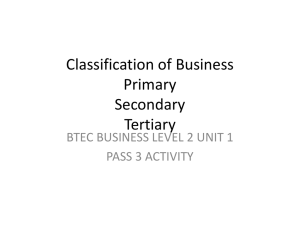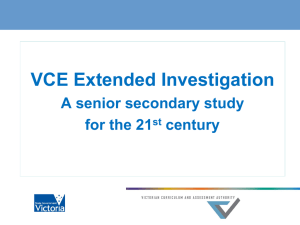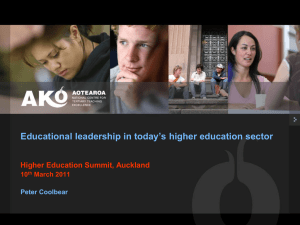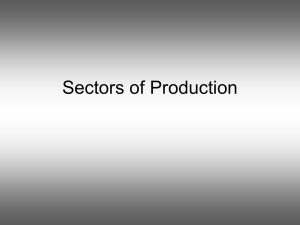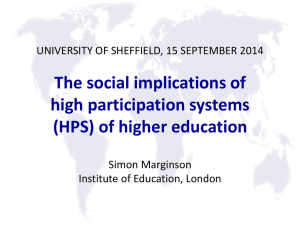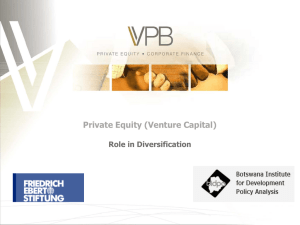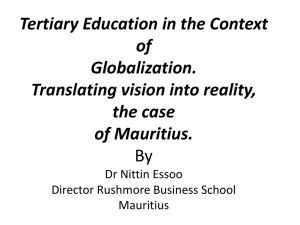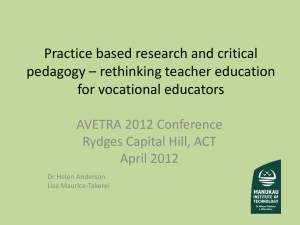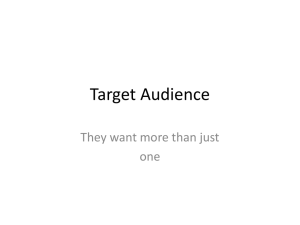TE Policy - BOTA
advertisement
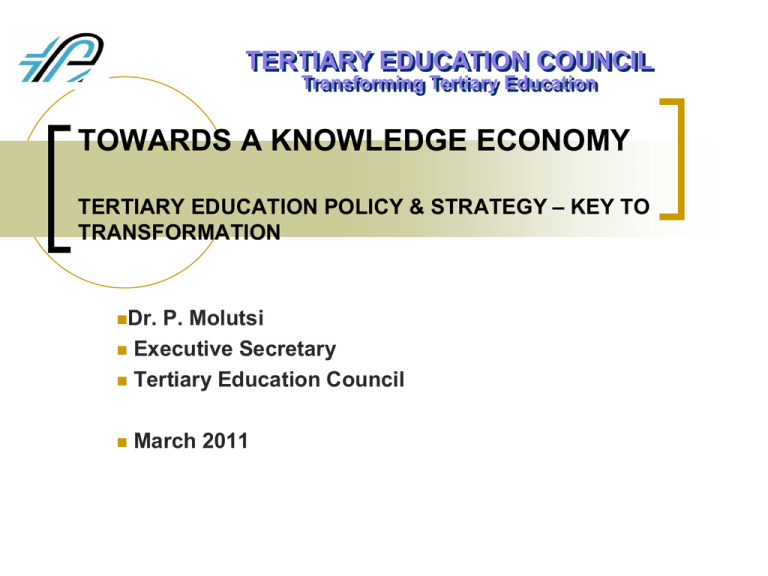
TERTIARY EDUCATION COUNCIL Transforming Tertiary Education TOWARDS A KNOWLEDGE ECONOMY TERTIARY EDUCATION POLICY & STRATEGY – KEY TO TRANSFORMATION Dr. P. Molutsi Executive Secretary Tertiary Education Council March 2011 The Progress Model. 1966 3 km 6 Sec School 4/9/2015 Now 6367 km 233 60.00 GDP capita 18,340 Bottom 25 poorest Upper 2 Middle Income Political Stability. 90 -100 percentile Most stable democracy in the world 4/9/2015 3 Macro Economy 90-100 percentile Global ranking (2007) 41 (128) 4/9/2015 4 Institutional Regime 90-100 percentile Global Ranking (2007) 38 (128) 4/9/2015 5 Other Key Enablers 2007 Global Rankings Infrastructure – 67 (128) Market Efficiency – 61 (128) 4/9/2015 6 Knowledge Economy Index Most recent 10 Sweden 9.17 8 6 S. Africa 4.89 Mauritius 4.25 Botswana 4.20 4 Africa 2.46 2 0 1 4/9/2015 2 3 4 5 6 1995 7 8 9 10 7 Development Stage Stages of Development Characteristics Unskilled Resource Driven Investment Driven Innovation Driven 4/9/2015 and low wage labour Cheap Natural Resources A strategic shift in the economy towards a knowledge intensive service sector Domestic knowledge generation New and unique innovations 8 Peer & Comparator Countries Stages of Development Resource Driven Countries Africa A to Z Botswana Algeria Transition from 1-2 Libya Namibia Tunisia Investment Driven 4/9/2015 Innovation Driven Mauritius South Africa Canada USA and Australia 9 The Burning Platform 4/9/2015 10 Resource Dependency Diamonds are NOT forever 4/9/2015 11 The most Problematic areas The most problematic factors for doing business in Botswana 2007 vs 2003 0 2 4 6 8 % of respondents 10 12 14 16 18 20 A. Bureaucracy B. Educated workforce C. Access to financing D. Work ethic E. Labour regulations F. Inflation G. Infrastructure H. Corruption I. Crime and theft J. Tax rates K. Foreign currency regulations L. Policy instability M. Tax regulations N. Government 4/9/2015 instability/coups * based on an Executive Opinion Survey conducted in 2007 and 2003 by World Economic Forum 2007 2003 12 What Botswana must get right Key Enhancers Tertiary Education Health & General education Current global rankings 89 (128) 115 (128) Technological readiness 81 (128) Business sophistication 98 (128) Innovation 92 (128) 4/9/2015 13 Knowledge Economy Index – Tertiary Education Pillar Unive rs ity indus try link s 8 6 4 Innovation 2 Te rtiary Enrollm e nt 0 S& T Journal article s Re s e arche rs Bots w ana 4/9/2015 South Africa M auritius 14 Tertiary Education Policy. Republic of Botswana Ministry of Education TOWARDS A KNOWLEDGE SOCIETY WHITE PAPER ON TERTIARY EDUCATION 4/9/2015 15 March 2008 Tertiary Education Driver of Development. Resource 4/9/2015 Transition Investment Stages of Development Innovation 16 Value Proposition. BENEFITS Tertiary Institutions Employment & Salaries Goods & Services Student expenditures OUTCOMES Botswana’s Aggregate Wealth Skilled & Adaptable People Quality Jobs Enhanced Income Personal Development Knowledge Discovery Research & Innovation Product development Investment & Income 4/9/2015 Botswana’s Societal Advancement and Quality of Life 17 VISION 2016 ALIGNMENT Prosperous & Productive Policy Fit Policy Execution Educated & Informed Open, Democratic & Accountable 1. Human Resource Development 2. Research & Innovation 3. Economic & Social Transformation 4/9/2015 Safe & Secure United & Proud Tertiary Education NATIONAL DEVELOPMENT PLAN 2009-2016 Compassionate, Just & Caring Moral & Tolerant 18 Policy Goal -1. HUMAN 4/9/2015 RESOURCE DEVELOPMENT; 19 Human Resource Development Key Driver since 1960s. M anpower Foreca sti ng Core Issues Core Issues LABO UR ACADEM IC PROGRAM M E MARKET LABO UR MARKET S UPPLY DEMAND Core O BJECTIVE 4/9/2015 • • Filling curren t an d forecast v acancies Localisation of expatria te held p ositio ns 22 20 Educational Attainment 140 120 100 Primary 80 Secondary 60 Tertiary 40 Adult literacy 20 0 70 980 985 990 991 992 993 994 995 996 003 007 9 1 1 1 1 1 1 1 1 1 1 2 2 4/9/2015 21 Peers and Comparators Botswana South Africa 11.4% 4/9/2015 15.3% Mauritius New Zealand 17.2% 63.2% 22 Government Spend on Tertiary Education Botswana 18.6 % 4/9/2015 South Africa 14.6% Mauritius 15.6% New Zealand 24.9% 23 Tertiary Education Problem Tree. PROBLEMS MAJOR EFFECTS ACCESS DISCONNECTS •Strategy •Structures QUALITY •Systems 4/9/2015 RELEVANCE 24 Tertiary Employment Problem Tree. PROBLEMS MAJOR DISCONNECTS EFFECTS GRADUATE UNEMPLOYMENT •Strategy •Structures SKILLS DEFICIT •Systems 4/9/2015 TRADITIONAL GRADUATES 25 Tertiary Education Enrollment Goal. 350000 300000 250000 200000 150000 100000 50000 0 2007 2016 2020 18-24 Population Projection 270361 284759 299371 Tertiary enrolm ents 31,129 48,409 59,875 11.4 17 20 Gross Enrollm ent ratio 4/9/2015 18-24 Population Projection Tertiary enrolm ents Gross Enrollm ent ratio 26 Policy Goal -2. RESEARCH 4/9/2015 & INNOVATION 27 Exciting Challenges. “The battle for ideas is on and it is up to us as a nation as to whether we want to join the leaders and be counted.. It has worked for small states such as Finland, Ireland, Singapore, Taiwan, South Korea, Mauritius,.. 4/9/2015 28 What keeps Botswana behind? Very small S&T HR base (~ 2, 160 employees within S&T system) R&D personnel as % of total employment is below optimal (<2.7 researchers per 1000 employed) Low GERD (gross expenditure on R&D as % of GDP) Most research focussed on wrong areas that do not have long term ‘high value’ e.g. agricultural, manufacturing Inadequate management of S&T such as indicators, priority areas, monitoring, political S&T leadership Overly focussed on import of technologies which restricts breakthrough ideas Current University bias towards a teaching Poor patent record (5 patents by 2004?) e.g. >500K /yr in Japan Thinking that strengthening traditional attributes will bring lasting prosperity 4/9/2015 29 Botswana - a small but heavy state 4/9/2015 Vision 2016 - 1997 S&T Policy - 1998 New Zealand Consortium Report for a framework - 2000 Ministry of Communications Science and Technology - 2002 Botswana National Research Science and Technology Plan - 2005 Maitlamo ICT Policy (e-government, legal etc) - 2006 Botswana Innovation Hub (BIH) Business Plan – 2006 Botswana International University of S & T 2003 Medical School - 1998 SLOW RECORD OF IMPLEMENTATION …..Need to remember that we are playing catch-up! 10 years to implement a policy or project is too long… 30 Innovation Model 60 Radical Innovation 50 Revenue 40 Evolutionary Innovation 30 20 10 Business as Usual 0 -4 4/9/2015 -3 -2 -1 Today 1 2 3 Planning Horizon 4 31 Choices and Consequences QUANTUM GROWTH STAGNATE DECLINE 4/9/2015 32 Tertiary Education Research & Innovation System ideas RESEARCH & INNOVATION 4/9/2015 33 Tertiary R & I Value Chain RESEARCH Market Needs Concept/ Idea INCENTIVES Research Allocations 4/9/2015 Basic R&D FUNDING ( Research Allocations ) INNOVATION Applied R&D Prototype R&I FUNDING Pilot Production Early Growth Production Mature Production (Venture Capitalists, Industry, Banks, other financiers.) 34 Policy Goal -3. SYSTEM 4/9/2015 & INSTITUTIONAL CAPACITY 35 System Level Fragmentation. 4/9/2015 36 A Single Accountability. Ministry of Education and Skills Training Department of Tertiary Education Human Resource Development Council 4/9/2015 Skills Training and Development Tertiary Education Human Resource Development 37 INSTITUTIONAL PROFILES Learnin Internal g& Processes Growth Financi al Customers Educational Excellence Organisational Excellence Partnership Excellence Increase opportunities for lifelong education Improve resource management Strengthen relationships with stakeholders/customers Improve quality of programmes Improve quality of service at FCTVE Increase number of partnerships Produce marketable graduates Strengthen the cultural values of the organisation Improve quality of service at FCTVE Effective financial management Effective procurement strategies Improve resource management Perception audits Programme Audits Improve utilisation of resources Flexible modes of delivery Improve resource management Marketing strategies Relevant programmes Process mapping Network with corporate world Market surveys Organisational culture inductions Performance reforms implementation Team spirit culture Uphold code of conduct Funding Strategy. High low 4/9/2015 High low High low 39 A new Institutional Landscape. Satellite Campus A new Institutional Institute of Health Science ☼ Satellite Campus Satellite Campus Colleges Of Technology Satellite Campus 4/9/2015 ☼ ☼ Private ☼ Institution ☼ ☼ ☼ ☼ Satellite Campus BOCODOL Open & Distance Learning Satellite Campus Education & Community Colleges ☼ ☼ ☼ ☼ ☼ Private ☼ Institution ☼ ☼ ☼ ☼ ☼ ☼ Private Institution ☼ UB Comprehensive Research Intensive University ☼ ☼ ☼ BIUST Science and Technology University 40 SYSTEM-INSTITUTIONAL GOVERNANCE MODEL. Control Steering Autonomy high low 4/9/2015 41 Qualifications Framework LEVEL 10 9 8 7 6 1-5 4/9/2015 QUALIFICATION TYPE Ph.D Masters Undergraduate degree Diplomas Certificate General education to Senior Secondary 42 Policy Implementation Managing by Project Developing our People 4/9/2015 43 Managing by Project. NDP9 NDP10 Beginning and End INITIATION PLANNING Initiate Formulate EXECUTION & CONTROL Execution & Monitor CLOSEOUT Review & Evaluate Developing our People. S U C PLAN & MANAGE CAPACITY LEADERSHIP E CAPABILITY S S
